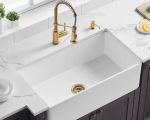How to Install a New Range Hood in the Kitchen
Installing a new range hood in the kitchen is an excellent way to improve air quality and ventilation while cooking. As someone who enjoys cooking regularly, I’ve found that having the right range hood can make a huge difference in both the comfort and cleanliness of my kitchen. Whether you're replacing an old model or installing a new one for the first time, this guide will walk you through the process in a way that's easy to follow, even for beginners.
Why a Range Hood is Essential for Your Kitchen
A range hood is an essential appliance in any kitchen. Not only does it help remove cooking odors, smoke, and steam, but it also plays a crucial role in maintaining good indoor air quality. When cooking, grease, moisture, and other contaminants can build up, making the air less breathable. A range hood helps to extract these particles, keeping your kitchen fresher and reducing the risk of mold and other moisture-related issues. This is especially important in areas where ventilation might be poor, such as in apartments or closed-off kitchens.
Choosing the Right Range Hood
The first step in installation is selecting the right range hood for your needs. When choosing a range hood, you need to consider several factors such as:
- Size: The range hood should be at least as wide as your stove or cooktop. Ideally, it should extend a few inches beyond the edges of the cooktop for optimal coverage.
- Style: There are various styles available, including wall-mounted, under-cabinet, and island range hoods. Choose a style that suits your kitchen layout and aesthetic preferences.
- Power: The power of the fan (measured in CFM – cubic feet per minute) determines how effectively it will remove smoke and odors. A higher CFM is better for larger kitchens or high-heat cooking methods like grilling or frying.
- Filtration Type: Range hoods typically come with two types of filters: charcoal and metal. Charcoal filters are ideal for recirculating hoods, while metal filters are used in vented hoods.
Tools and Materials You’ll Need for Installation
Before you start the installation process, make sure you have all the necessary tools and materials. Here’s a basic list of what you’ll need:
- Range hood kit (including fan, ductwork, and necessary mounting hardware)
- Power drill and bits
- Measuring tape
- Level
- Screwdriver
- Wire stripper (for electrical connections)
- Electrical tape or wire nuts (if applicable)
- Safety goggles and gloves
Step-by-Step Guide to Installing Your Range Hood
1. Turn Off the Power
Before doing any electrical work, ensure the power to the kitchen is turned off. This will prevent any electrical accidents while installing your range hood.
2. Measure and Mark the Mounting Location
Using your measuring tape, find the correct height for your range hood. Most range hoods are installed 24-30 inches above the stove. Mark the spots where you’ll need to drill holes for the mounting brackets.
3. Install the Mounting Bracket
Secure the mounting bracket to the wall or cabinetry using a power drill. Make sure it’s level, as this will ensure your range hood is properly aligned.
4. Install the Ductwork (If Applicable)
If you’re installing a vented range hood, you’ll need to connect the ductwork. Attach the ducting to the range hood’s exhaust port and secure it to the vent opening in your wall or ceiling. Ensure there are no sharp bends in the ductwork, as this can affect the airflow efficiency.
5. Mount the Range Hood
With the bracket in place, carefully lift the range hood into position and attach it to the bracket with screws. Be sure to check the alignment again to make sure everything is straight and secure.
6. Connect the Electrical Wires
For models that require electrical wiring, connect the wires according to the manufacturer’s instructions. If you’re not comfortable doing this yourself, it’s a good idea to hire an electrician to handle the wiring.
7. Test the Range Hood
Once the range hood is securely installed, turn the power back on and test the unit. Check for any issues with the fan speed, lighting, or other features to ensure everything works properly.
Additional Tips for Range Hood Maintenance
Maintaining your range hood is crucial for its longevity and optimal performance. Here are a few tips to keep in mind:
- Clean the filters regularly: Depending on your model, the filters should be cleaned every 1-3 months to prevent grease buildup and maintain efficiency.
- Check the fan regularly: Listen for any unusual noises or vibrations. If the fan is making excessive noise, it could indicate that it’s clogged or needs maintenance.
- Replace the charcoal filter: If you have a recirculating range hood, the charcoal filter should be replaced every 6 months for optimal odor removal.
Installing a new range hood may seem like a daunting task, but with the right tools and instructions, it’s a straightforward process that can greatly improve the comfort and safety of your kitchen. Whether you’re upgrading an old unit or installing a new one, following these steps will help ensure that the job gets done right.








